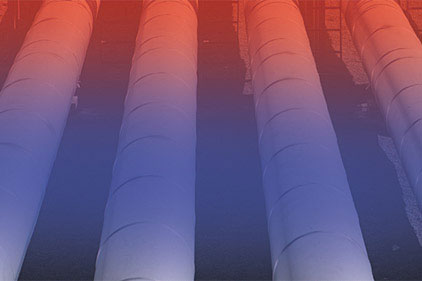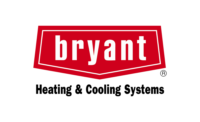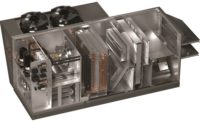After reviewing basic design options, the next steps for potential geothermal designers are to challenge the common concerns and myths, study how different choices have different cost impacts, and be aware of the ways a good design can yield bad performance if the installation isn’t done well. Add the habit of turning a retrofit’s circumstances to your advantage, and this underground approach can rise above client expectations in short order.
Geothermal heating and cooling systems, also called geo-exchange systems, have been used for years as alternatives to, or in conjunction with, traditional HVAC systems, transferring heat via the ground instead of the air. In some regards, geothermal has not become a system of choice by engineers due to the challenges it has faced in the industry and a general lack of knowledge about proper design and installation. There are also misconceptions about the cost and use of geothermal units.
Improvements have been made in the equipment over the years, and today’s geothermal units, when installed and used properly, offer many advantages, including long-term energy and cost savings and environmental friendliness. There are also ways to be creative in the installation and design of geothermal systems to get maximum benefit from its many types of applications.
TYPES OF GEOTHERMAL SYSTEMS
Geothermal units use flowing water to extract heat from the ground in the winter and discharge heat into the ground in the summer. The most common geothermal system is a ground source heat pump that cycles water through an underground piping loop. The water piped through this loop uses the difference in the earth’s temperature to transfer heat into, or away from, the refrigeration cycle by means of a heat exchanger.
There are three general types of geothermal systems: open loop, closed loop, and hybrids. The traditional closed loop system piping is installed underground and can be trenched horizontally or bored vertically. If the facility is near a lake or pond, piping can even be coiled underwater on the lake bed, if the bed is deep enough.
Open loop systems use a dedicated well with a submersible pump as the source of water delivered to the heat pump. Once the water is cycled through the system, it is returned through a second well drilled specifically for this purpose, or to a nearby stream or lake.
Hybrid systems use some piping and an evaporative cooler also. You can get creative in using different types of loops to achieve the best results for both cost and energy savings. For example:
- Save money on installations by looking at heating vs. cooling load
- Size piping for heating load and supplement cooling with an evaporative condenser.
Geothermal systems also come in many different configurations. Manufacturers offer products including the traditional air handler, desuperheater (for heating water either domestically or process), dehumidification systems, dedicated outdoor air system, and water-to-water (with single or double-wall heat exchanger). These systems may also offer different compressor staging options allowing part loading scenarios to be very effective. Additionally, some manufacturers can offer customized equipment which is very appealing in retrofit projects. With these configurations, geothermal has a wide array of uses and its applications are almost endless.
ENERGY USE
First, it is important to remember that geothermal is on an energy efficiency ratio (EER) rating system, which is different than most conventional equipment. Smaller refrigerant-based equipment is based on the seasonal energy efficiency ratio (SEER) rating. EER is the ratio of the cooling capacity of the air conditioner in Btuh to the total electrical input in watts under AHRI-specified test conditions.
Determine which system the equipment is rated on before you try to compare. In the United States, the ratio between SEER and EER is different for various locations. Outside the Loop, a geothermal publication sponsored by a host of supporters and headed by Dr. Steve Kavanaugh, makes a compelling argument for comparing these two values. In the 1999 summer edition, Volume 2 Number 3, page 6, SEERs and EERs in Chicago and Atlanta are used to illustrate the difficulty in comparing these values. The calculations indicate that more energy savings may be realized quicker in Chicago weather than Atlanta’s climate. You can find this newsletter and other information about geothermal systems online athttp://geoheat.oit.edu/otl/otl02-03.pdf.
ASHRAE 90.1 develops a baseline for different types of systems so you can then realize energy savings above the baseline. ASHRAE 90.1-2010 has a couple of different methods for computing this energy savings and seeks to achieve 30% more energy savings over the 2004 version. ASHRAE 90.1 acknowledges that geothermal has a better energy efficiency and savings because the baseline system has a higher efficiency rating than other types of systems, in most cases by 25%. Geothermal meets all LEED® requirements for refrigerant usage, including zero ozone depletion, but really shines in energy savings.
COMMON CONCERNS AND MYTHS
The cost of geothermal
Most clients installing geothermal are not looking at upfront costs as much as energy savings and simple payback (taking savings realized through energy compared to the additional cost of a system). Typical payback on a geothermal system can be as low as two years, depending on these upfront costs and the systems being compared. Other things to consider in achieving greater savings and reducing payback include:
- Air handlers in the building: Should they be combined into a central unit or split up into smaller units?
- Ductwork and piping lengths: If I design more localized air handlers, then ductwork costs and fan energy goes down but piping may increase.
- Not multiplying associated equipment costs: Multiple geothermal units may increase upfront cost due to more equipment, but they also may increase localized pumping, more fans, more maintenance, etc.
- As geothermal becomes more mainstream, costs go down: It may seem obvious, but the laws of supply and demand exist in the engineering community.
Creativity helps to reduce some initial costs of the geothermal system and to realize the savings much faster. For example, some utility companies offer rebate programs and some will also finance a portion of the upfront costs, allowing payments made over time. Visit www.Dsireusa.org for available rebates and savings by state.
Database of state incentives: www.dsireusa.org/incentives/index.cfm?EE=1&RE=1&SPV=0&ST=0&technology=geothermal_direct&sh=1
MAINTENANCE AND CONFIGURATION
Another common concern is maintenance and configuration of the systems. Due to unfamiliarity, some engineers resist learning how to effectively design and implement these types of systems, often claiming that geothermal equipment is very maintenance-prone or that it will not work in many applications. Typically, the only aspect within the geothermal system that requires routine maintenance is the pumps. Maintenance has no more of an impact on geothermal systems than on a chiller/boiler system (excluding cooling tower servicing) or on a common split system. Some are concerned with a system involving pipes in the ground. The pipes, if properly fused together and installed properly per the manufacturer’s recommended methods, are warranted for at least 50 years. When developing maintenance/cost budgets for geothermal systems, care needs to be taken in assessing the true maintenance costs between systems since there is little difference between these systems and traditional systems.
LESSONS LEARNED
Before the project begins, an engineer or owner needs to have a thermal conductivity test of the area where the ground loops will be installed. The test involves drilling a bore in the ground, setting up one loop of pipes, and then conducting a 24-hr period test to see what the capacity of the ground has for absorbing heat. This test will indicate how readily the ground will accept or reject heat and it is vital for calculating how much piping must be installed. In some cases, several bore tests may need to be performed since the soil properties may change dramatically within a 20-ft radius from one bore to the next. The values obtained from the tests can be plugged into one of several computer programs that help in the designing of the loop field for the specific application. Designing geothermal systems is more of a science now than in the past because of all the tools available.
When doing horizontal loops, it is important to ensure there is good burial depth. The average depth should be six feet so the loops function independently from the frost line, surface radiation, and fluctuations in air temperature, and therefore can maintain a constant interaction with the soil and a constant fluid temperature.
On one job, the contractor did not understand the process, and because the burial depth was not consistent, he buried the pipe 6 ft in some places but only three or four feet in other areas. It created problems for the loops and the design and was eventually dug up and reburied.
It is important to find contractors who understand the system, the deployment strategy of the engineer of record, and how to perform a proper installation. Training is available to help contractors better understand how to install these systems. Engineers should include in their specifications that contractors have not only the proper training, but that they have also the proper experience installing geothermal systems. Many geothermal installations have had a good design, but when the contractor takes too many liberties in installing the system the way he thought it should be, the system functions improperly.
Finally, I encourage engineers to use their creativity. One project had a chiller/boiler system in place. It was not feasible to completely remove the old system, and the chiller and boilers were the only equipment past useful life. Instead of replacing the whole system, a water-to-water geothermal system was recommended to be installed in its place. This allowed for immediate energy and cost savings just by installing the necessary components to change over to a geothermal system.
Another option is to design and install a hybrid system, combining different geothermal design strategies into a holistic, single-system approach. Another time, a ground loop was designed to handle the heating needs of the facility and supplemented with a fluid cooler to accommodate the additional cooling load. For a project with a golf course, water was taken from a pond, used as process, and circulated through the system. The water was then discharged into a pond upstream. The discharge outlet of the pipe was pointed up to create a water fountain feature that aerates the water, dispelling the heat as it comes out.
If engineers will think outside of the box and be more creative with their designs, geothermal will continue to increase comfort, be environmentally friendly, deliver significant utility cost savings, and become the preferred system for owners and users across this country and around the world. ES




